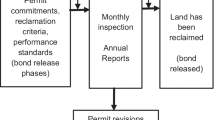Abstract
Derelict land is a wasted resource and has a blighting effect on the surrounding area hence its restoration is highly desirable. Four case histories involving different aspects of dereliction and restoration are outlined. The first example considers two old colliery spoil heaps in South Yorkshire, England, which were restored, part of the site being developed for a bakery whilst the rest became a parkland. Such restoration work is essentially a large-scale exercise in earthmoving in order to achieve an acceptable contoured landform. After regrading, installation of drainage and harrowing, the spoil was treated with lime and covered with soil. Fertilizers were applied prior to seeding and planting. The next example describes an abandoned sand and gravel pit in West Yorkshire which was converted to a marina. The old workings were flooded and were separated by two berms into three large ponds. The berms were moved to form a lake with islands. Some regrading of the sides of the lake was necessary which involved cut- and -fill. Access was provided from the lake to an adjacent canal and the site was landscaped. The two remaining examples are from the heavily industrialized district of the Ruhr in Germany. Both were sites of former coal mining and associated industries and were contaminated as well as having old heavy foundation structures in the ground. The site investigations and rehabilitation of both areas are described.
Résumé
Les sites abandonnés constituent une ressource gaspillée et présentent un effet dégradant sur les régions avoisinantes. C'est pourquoi leur restauration est hautement souhaitable. Quatre études de cas concernant différents aspects de l'abandon et de la restauration sont présentées. Le premier exemple se rapporte à deux vieux terrils du sud du Yorkshire (Angleterre), qui furent restaurés, une partie du site étant aménagé pour une boulangerie tandis que le reste était transformé en espace naturel. De tels travaux de restauration conduisent à des mouvements de terres à grande échelle pour obtenir de nouvelles formes topographiques. Après terrassement des matériaux, installation de drainages et labour, les produits de terril ont été traités à la chaux et recouverts d'un sol. Des engrais ont été répandus avant ensemencement et plantation. L'exemple suivant est relatif à une exploitation abandonnée de sables et graviers de l'ouest du Yorkshire qui fut transformée en une marina. Les anciennes exploitations furent submergées et divisées par deux digues en trois grands bassins. Les terrassements permirent de former un lac avec des îles. Quelques travaux d'extraction et de remblaiement furent nécessaires pour l'aménagement des rives du lac. Le lac fut reliéà un canal voisin et un traitement paysager du site fut réalisé. Les deux autres exemples concernent la région fortement industrialisée de la Ruhr, en Allemagne. Les deux sites correspondant à d'anciennes exploitations de charbon et industries associées étaient contaminés et comportaient des ouvrages aux lourdes fondations. Les études de site et les travaux de réhabilitation de ces deux régions sont décrits.
Similar content being viewed by others
Author information
Authors and Affiliations
Additional information
Received: 10 September 1999 · Accepted: 11 April 2000
Rights and permissions
About this article
Cite this article
Bell, F., Genske, D. Restoration of derelict mining sites and mineral workings. Bull Eng Geol Env 59, 173–185 (2000). https://doi.org/10.1007/s100640000066
Issue Date:
DOI: https://doi.org/10.1007/s100640000066




